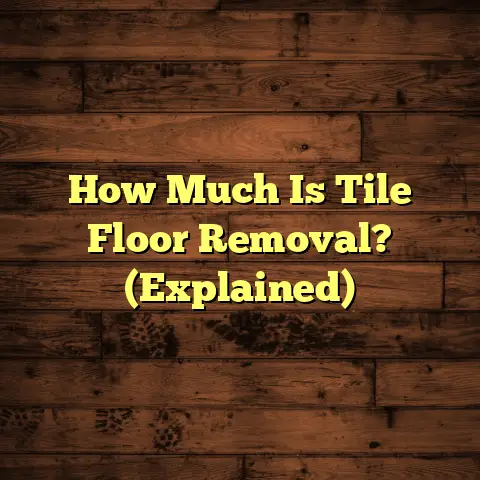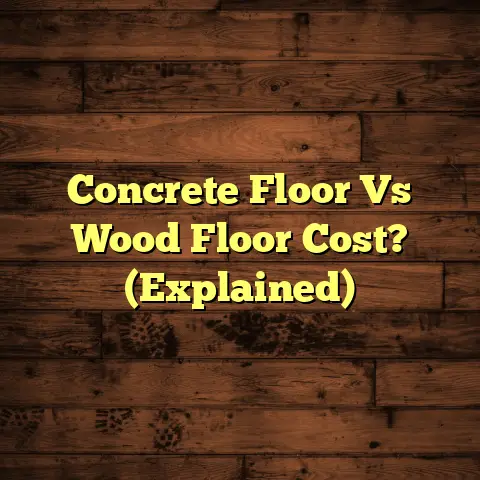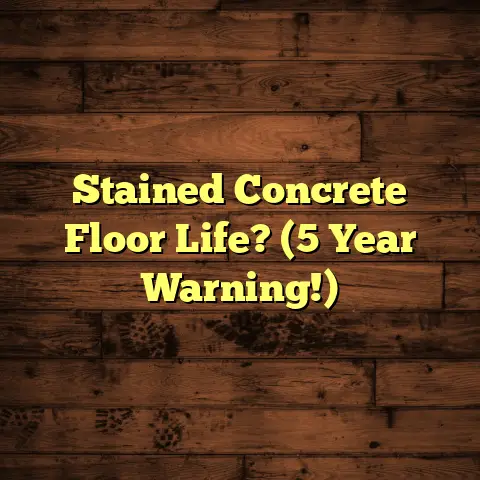Why Do Floors Warp? (7 Fixes, Fast!)
It’s not just about looking good; it’s about functionality and safety too.
Ever tripped over a warped floorboard? Not fun!
I’m here to dive deep into the frustrating world of warped floors.
We’ll explore why it happens to different materials – hardwood, laminate, tile, vinyl – and, most importantly, what you can do about it.
I’ve seen it all in my years as a flooring contractor, and I’m excited to share my knowledge with you.
Let’s get started and uncover the secrets to keeping your floors flat and fabulous!
Room-Specific Needs
Flooring isn’t a one-size-fits-all deal. What works in the bedroom might be a disaster in the bathroom.
Let’s break it down room by room.
Living Room
The living room: it’s where we chill, entertain, and make memories.
It needs a floor that can handle it all.
I’ve seen living rooms with beautiful hardwood floors buckle due to moisture from open windows during rainy days.
And don’t forget the constant foot traffic. A durable, stable floor is key.
Kitchen
Ah, the kitchen – the heart of the home! But also a danger zone for floors.
Spills, splashes, and constant moisture can wreak havoc, especially on laminate and hardwood.
I once had a client whose laminate floor near the sink was completely ruined because of a slow, unnoticed leak.
Bathroom
Bathrooms are the ultimate challenge. High humidity and moisture levels are constant.
Tile and vinyl are popular choices, but even they can warp if not installed properly or if ventilation is poor.
I always recommend clients invest in a good exhaust fan. It makes a world of difference!
Basement
Basements are notorious for moisture issues. Groundwater seeping up can cause serious warping, regardless of the flooring material.
Proper sealing and choosing moisture-resistant materials are crucial.
I’ve seen basements where the entire floor needed to be replaced because the owners didn’t install a proper moisture barrier.
Bedroom
Bedrooms are all about comfort and aesthetics. But even here, floors aren’t immune to warping.
Temperature and humidity fluctuations can cause problems over time.
I’ve noticed that hardwood floors in bedrooms tend to expand and contract more than in other rooms due to varying heating and cooling.
Office Space
Office floors need to withstand heavy furniture, rolling chairs, and constant foot traffic.
Humidity control is essential, and choosing the right flooring material can make or break the space.
I’ve seen office spaces where the laminate floors started to buckle under the weight of heavy desks and filing cabinets.
Hallways and Entrances
These high-traffic areas take a beating. Wear and tear can lead to warping if you’re not careful.
Regular maintenance and durable materials are your best bet.
I always advise clients to use rugs or mats in entrances to protect the flooring from dirt and moisture.
Understanding the Causes of Floor Warping
So, what exactly causes floors to warp? Let’s break down the main culprits.
-
Moisture: This is the number one enemy of most flooring materials.
Water can cause wood to swell, laminate to delaminate, and even tile to crack. * Temperature Fluctuations: Extreme temperature changes can cause floors to expand and contract, leading to warping over time. * Poor Installation: This is a big one. Improperly installed floors are much more likely to warp. * Type of Flooring Material: Some materials are simply more prone to warping than others.
For example, solid hardwood is more susceptible to moisture damage than engineered hardwood.
Let’s dive deeper into the science of it all.
Wood, for example, is a hygroscopic material, meaning it readily absorbs and releases moisture from the air.
This causes it to expand when humidity is high and contract when it’s low.
According to the Forest Products Laboratory, wood can change dimension by several percentage points as moisture content changes. Forest Products Laboratory
Laminate flooring, on the other hand, is made of several layers of materials bonded together.
If moisture penetrates the core layer, it can cause the laminate to swell and separate.
Tile is generally more resistant to moisture than wood or laminate, but it can still crack or become uneven if the subfloor is not properly prepared.
Understanding these dynamics is crucial for effective maintenance and prevention.
The Seven Fast Fixes for Warped Floors
Alright, let’s get to the good stuff – how to fix warped floors!
Here are seven effective solutions I’ve used countless times.
1. Humidity Control
Maintaining optimal humidity levels is crucial. Too much or too little humidity can cause floors to warp.
- Dehumidifiers: Use these in damp areas like basements to remove excess moisture from the air.
- Humidifiers: In dry climates, use humidifiers to add moisture to the air and prevent floors from drying out and cracking.
I recommend keeping humidity levels between 30% and 50%.
You can use a hygrometer to monitor the humidity in your home.
2. Proper Installation
I can’t stress this enough: proper installation is key to preventing warping.
-
Acclimation: Allow flooring materials to acclimate to the room’s temperature and humidity for several days before installation.
This prevents them from expanding or contracting excessively after installation. * Underlayment: Use the appropriate underlayment for your flooring material.
This provides a moisture barrier and cushions the floor, reducing the risk of warping.
I’ve seen so many cases where floors warped simply because they weren’t acclimated properly. Don’t skip this step!
3. Regular Maintenance
A little maintenance goes a long way.
-
Cleaning: Clean floors regularly with a damp mop and a mild cleaner.
Avoid using excessive water, which can seep into the seams and cause warping. * Protection: Use rugs or mats in high-traffic areas to protect the flooring from wear and tear. * Sealing: Seal grout lines in tiled floors to prevent moisture from penetrating the subfloor.
Here’s a maintenance checklist tailored to each room:
- Living Room: Vacuum or sweep regularly to remove dirt and debris.
- Kitchen: Clean up spills immediately to prevent moisture damage.
- Bathroom: Wipe down surfaces after showering to reduce humidity.
- Basement: Check for leaks regularly and address them promptly.
- Bedroom: Dust and vacuum regularly to prevent allergens from accumulating.
- Office Space: Use chair mats to protect the flooring from rolling chairs.
- Hallways and Entrances: Place mats at entrances to trap dirt and moisture.
4. Use of Barriers
Moisture barriers are your best friend in areas prone to water exposure.
- Basements: Install a vapor barrier under the flooring to prevent moisture from seeping up from the ground.
- Bathrooms: Use a waterproof membrane under tile or vinyl flooring to protect the subfloor from moisture.
I always recommend using a 6-mil polyethylene vapor barrier in basements. It’s a simple and effective way to prevent moisture problems.
5. Material Selection
Choosing the right flooring material for each room is crucial.
- Hardwood: Beautiful but susceptible to moisture damage. Best for living rooms and bedrooms.
- Engineered Hardwood: More resistant to moisture than solid hardwood. Good for kitchens and basements.
- Laminate: Affordable and durable, but can warp if exposed to excessive moisture. Good for living rooms and offices.
- Tile: Highly resistant to moisture. Best for bathrooms and kitchens.
- Vinyl: Waterproof and durable. Good for bathrooms, kitchens, and basements.
Here’s a quick comparison table:
| Material | Moisture Resistance | Durability | Best For |
|---|---|---|---|
| Solid Hardwood | Low | High | Living Room |
| Engineered Hardwood | Medium | High | Kitchen, Basement |
| Laminate | Low to Medium | Medium | Living Room, Office |
| Tile | High | High | Bathroom, Kitchen |
| Vinyl | High | High | Bathroom, Kitchen, Basement |
6. Repairing Existing Damage
If your floors are already warped, don’t despair! There are ways to fix them.
- Sanding and Refinishing: For hardwood floors, sanding and refinishing can remove minor warping and restore the floor’s original appearance.
-
Replacing Sections: For more severe warping, you may need to replace sections of the flooring.
This is especially common with laminate and vinyl floors.
Here’s a step-by-step guide to replacing a warped section of laminate flooring:
- Use a utility knife to score the damaged section of laminate.
- Carefully pry up the damaged section using a pry bar.
- Clean the subfloor and apply a thin layer of adhesive.
- Cut a new section of laminate to the correct size and shape.
- Place the new section into the opening and press firmly.
7. Consulting Professionals
Sometimes, you just need to call in the pros.
- Inspections: If you’re unsure about the cause of the warping, hire a professional to inspect your floors.
- Repairs: For complex repairs, it’s best to hire a qualified flooring contractor.
When choosing a flooring contractor, look for someone with experience, a good reputation, and proper licensing and insurance.
I always tell my clients, “Don’t be afraid to ask questions!” A good contractor will be happy to answer them.
Conclusion
So, there you have it – a comprehensive guide to understanding and fixing warped floors.
Remember, prevention is always better than cure.
By controlling humidity, installing floors properly, maintaining them regularly, and choosing the right materials, you can keep your floors looking beautiful for years to come.
Don’t let warped floors get you down. Take proactive measures and enjoy your beautiful, stable floors!
If you’ve got any questions or need some personalized advice, feel free to reach out. I’m always happy to help!





